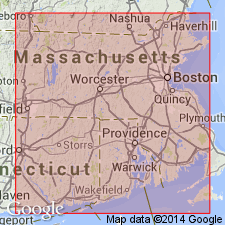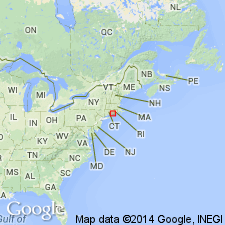
- Usage in publication:
-
- Rope Ferry Gneiss
- Modifications:
-
- Overview
- AAPG geologic province:
-
- New England province
Summary:
Usage of Waterford Group follows Goldsmith (1980; 1985). Described as a sequence of metavolcanic and metaplutonic plagioclase gneisses and amphibolites that unconformably overlies the Plainfield Formation in the Hope Valley terrane. (Hope Valley and Esmond-Dedham terranes compose the Avalon superterrane of this report.) Thickness of Waterford is variable; ranges to 3,100 m. Group is subdivided (ascending) into Mamacoke Formation with its upper Cohanzie Member (first used?), New London Gneiss, and Rope Ferry Gneiss. Rope Ferry described as locally massive, gray-colored, lenticularly layered hornblende-biotite-quartz-plagioclase gneiss. Thickness varies; averages 1,130 m. U-Pb analysis of zircon and sphene from the Rope Ferry yields a 620+/-3 Ma age. Protolith consisted primarily of mafic metavolcanic rocks. Unconformably underlies Potter Hill Granite Gneiss of Sterling Plutonic Suite.
Source: GNU records (USGS DDS-6; Reston GNULEX).

- Usage in publication:
-
- Rope Ferry Gneiss
- Modifications:
-
- Overview
- Areal extent
- AAPG geologic province:
-
- New England province
Summary:
Rope Ferry Gneiss described as "a medium- to coarse-grained plagioclase gneiss that forms a 40-km-long omega-shaped outcrop pattern around the Lyme dome." Unit may be as long as 55 km if Rodgers' (1985) mapping of the Rope Ferry is valid. Maximum width is 4 to 5 km near Waterford and Essex. Tapers to 300 m at northern edge. The name is retained in this report but applied only to rocks in this continuous belt. Unit is characterized by abundance of amphibolite xenoliths. Distinctive massive structure due to even distribution of mafic minerals and lack of feldspar-rich layers. Chemical analysis reveals that rock is granodioritic to tonalitic. Similar mineralogically to Boulder Lake Gneiss (new name), but higher in MgO and FeO. Both are intrusive and described as orthogneisses.
Source: GNU records (USGS DDS-6; Reston GNULEX).
For more information, please contact Nancy Stamm, Geologic Names Committee Secretary.
Asterisk (*) indicates published by U.S. Geological Survey authors.
"No current usage" (†) implies that a name has been abandoned or has fallen into disuse. Former usage and, if known, replacement name given in parentheses ( ).
Slash (/) indicates name conflicts with nomenclatural guidelines (CSN, 1933; ACSN, 1961, 1970; NACSN, 1983, 2005, 2021). May be explained within brackets ([ ]).

